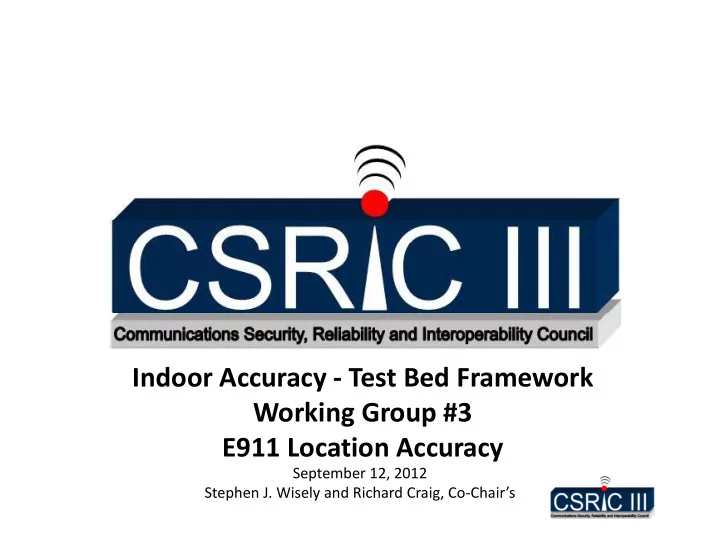

Indoor Accuracy ‐ Test Bed Framework Indoor Accuracy Test Bed Framework Working Group #3 E911 Location Accuracy E911 Location Accuracy September 12, 2012 Stephen J. Wisely and Richard Craig, Co ‐ Chair’s
Test Bed High Level Overview F ll Fully answer the FCC’s questions on indoor performance of E911 th FCC’ ti i d f f E911 Ultimate Goal location technologies Dense urban, urban, suburban and rural areas , , M Morphologies h l i Representative performance data applicable to a cross ‐ section of the country Different building types identified by construction and use Building Types g yp commercial, residential, wood, brick, concrete/steel, etc. i l id ti l d b i k t / t l t All technologies will be tested at common, undisclosed test points Test Points Deilverable timing may impact number but goal is statistical validity All testing, including ground truth creation, to be performed by an Testing Entity independent, 3 rd party, testing entity
Test Bed Benefits • Performance data independently and objectively collected P f d t i d d tl d bj ti l ll t d • Blind selection of data points No “cherry picking” or pre ‐ test optimization • Trusted 3 rd party administration t d 3 rd T t d i i t ti Objectivity • Common test methodology across technologies • Broad range of morphologies Show technology strengths and weakness in various environments Sh t h l t th d k i i i t Testing costs spread among 7 technologies in stage 1 Cost savings Equal access to results including ground truth for future campaigns – entire Results industry benefits
Testing in two stages Stage 1 ‐ Target completion ‐ March 31, 2013 Stage 2 – Target TBD, set up after CSRIC III • Evaluation of existing technologies and • Evaluation of newer location technologies known new technologies on an ongoing basis • Prior to CSRIC III charter termination • Use methodology developed for Stage 1 • Proposed to be in San Francisco Bay area • Proposed to be in San Francisco Bay area • Funding and oversight to be explored • Funding and oversight to be explored • Provides diverse setting that spans all • Test focus refined as FCC needs evolve morphologies while being practical to p g g p execute within given time frame • Geographical coverage expanded as needed
Participating Companies Company Technology Boeing BTL Iridium only mode CommScope [1] DAS proximity detection Boeing NextNav Wide area beacons Polaris Wireless RF Fingerprinting Qualcomm ( in partnership with Verizon) Q l AGPS+AFLT+MCS AGPS+AFLT+MCS ( h h ) TruePosition UTDOA Carriers: ATT, Sprint, T ‐ Mobile and Verizon [1]: CommScope will be testing in limited scenarios
Stage 1 Test Bed Funding Model Through competitive RFI process ‐ firms familiar to WG3 participants Selection of Test and known to be capable and actively engaged in testing efforts today Bed Entity Directly between test bed entity and technology company or Contractual combination of technology company and participating carrier partner Relationships M Managed closely by test bed entity, NDAs between test bed d l l b b d i NDA b b d • Confidential & company and test participants directly Proprietary Info Carriers can see raw test data for all participants – with NDA only • Technology companies only see their own raw data gy p y • Contractual Deliverable to WG3 will be non ‐ proprietary report based on criteria Deliverable defined in the scope of services developed by WG3 Report to the FCC with commentary from WG3 providing some color Ultimate around feasibility and readiness of technologies – for public record Deliverable
•ID Participants •ID Available Carrier Networks High Level Test Bed Schedule High Level Test Bed Schedule •Develop test methodology & scope D l t t th d l & 2Q12 •Financial model •Geographical location of test area •Finalize: testing management & oversight of the testing, reporting and auditing process •Identification of specific buildings with access •Vendor carrier partnership agreement finalization •Selection of test house 3Q12 •Agreement on test plan •Fulfillment of test pre ‐ requisites F lfill t f t t i it •Dry run readiness review •Physical testing 4Q12 4Q12 •Data collection and management Data collection and management •Produce Report with Assessment •Analysis of data ‐ Completion of Preliminary Test Report •Audit and verification of Test Report •Assessment Report will have two parts: 1Q13 •(1) Performance observed •(2) Assessment of technology availability, standards impact, life cycle cost factors, and projected implementation timeline
Recommend
More recommend